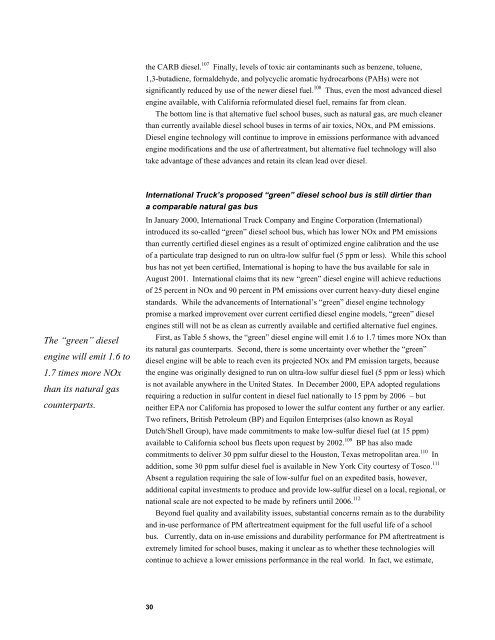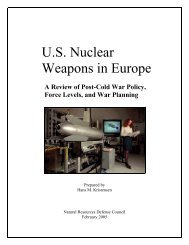NRDC: No Breathing in the Aisles: Diesel Exhaust Inside School ...
NRDC: No Breathing in the Aisles: Diesel Exhaust Inside School ...
NRDC: No Breathing in the Aisles: Diesel Exhaust Inside School ...
You also want an ePaper? Increase the reach of your titles
YUMPU automatically turns print PDFs into web optimized ePapers that Google loves.
The “green” diesel<br />
eng<strong>in</strong>e will emit 1.6 to<br />
1.7 times more NOx<br />
than its natural gas<br />
counterparts.<br />
<strong>the</strong> CARB diesel. 107 F<strong>in</strong>ally, levels of toxic air contam<strong>in</strong>ants such as benzene, toluene,<br />
1,3-butadiene, formaldehyde, and polycyclic aromatic hydrocarbons (PAHs) were not<br />
significantly reduced by use of <strong>the</strong> newer diesel fuel. 108 Thus, even <strong>the</strong> most advanced diesel<br />
eng<strong>in</strong>e available, with California reformulated diesel fuel, rema<strong>in</strong>s far from clean.<br />
The bottom l<strong>in</strong>e is that alternative fuel school buses, such as natural gas, are much cleaner<br />
than currently available diesel school buses <strong>in</strong> terms of air toxics, NOx, and PM emissions.<br />
<strong>Diesel</strong> eng<strong>in</strong>e technology will cont<strong>in</strong>ue to improve <strong>in</strong> emissions performance with advanced<br />
eng<strong>in</strong>e modifications and <strong>the</strong> use of aftertreatment, but alternative fuel technology will also<br />
take advantage of <strong>the</strong>se advances and reta<strong>in</strong> its clean lead over diesel.<br />
International Truck’s proposed “green” diesel school bus is still dirtier than<br />
a comparable natural gas bus<br />
In January 2000, International Truck Company and Eng<strong>in</strong>e Corporation (International)<br />
<strong>in</strong>troduced its so-called “green” diesel school bus, which has lower NOx and PM emissions<br />
than currently certified diesel eng<strong>in</strong>es as a result of optimized eng<strong>in</strong>e calibration and <strong>the</strong> use<br />
of a particulate trap designed to run on ultra-low sulfur fuel (5 ppm or less). While this school<br />
bus has not yet been certified, International is hop<strong>in</strong>g to have <strong>the</strong> bus available for sale <strong>in</strong><br />
August 2001. International claims that its new “green” diesel eng<strong>in</strong>e will achieve reductions<br />
of 25 percent <strong>in</strong> NOx and 90 percent <strong>in</strong> PM emissions over current heavy-duty diesel eng<strong>in</strong>e<br />
standards. While <strong>the</strong> advancements of International’s “green” diesel eng<strong>in</strong>e technology<br />
promise a marked improvement over current certified diesel eng<strong>in</strong>e models, “green” diesel<br />
eng<strong>in</strong>es still will not be as clean as currently available and certified alternative fuel eng<strong>in</strong>es.<br />
First, as Table 5 shows, <strong>the</strong> “green” diesel eng<strong>in</strong>e will emit 1.6 to 1.7 times more NOx than<br />
its natural gas counterparts. Second, <strong>the</strong>re is some uncerta<strong>in</strong>ty over whe<strong>the</strong>r <strong>the</strong> “green”<br />
diesel eng<strong>in</strong>e will be able to reach even its projected NOx and PM emission targets, because<br />
<strong>the</strong> eng<strong>in</strong>e was orig<strong>in</strong>ally designed to run on ultra-low sulfur diesel fuel (5 ppm or less) which<br />
is not available anywhere <strong>in</strong> <strong>the</strong> United States. In December 2000, EPA adopted regulations<br />
requir<strong>in</strong>g a reduction <strong>in</strong> sulfur content <strong>in</strong> diesel fuel nationally to 15 ppm by 2006 – but<br />
nei<strong>the</strong>r EPA nor California has proposed to lower <strong>the</strong> sulfur content any fur<strong>the</strong>r or any earlier.<br />
Two ref<strong>in</strong>ers, British Petroleum (BP) and Equilon Enterprises (also known as Royal<br />
Dutch/Shell Group), have made commitments to make low-sulfur diesel fuel (at 15 ppm)<br />
available to California school bus fleets upon request by 2002. 109 BP has also made<br />
commitments to deliver 30 ppm sulfur diesel to <strong>the</strong> Houston, Texas metropolitan area. 110 In<br />
addition, some 30 ppm sulfur diesel fuel is available <strong>in</strong> New York City courtesy of Tosco. 111<br />
Absent a regulation requir<strong>in</strong>g <strong>the</strong> sale of low-sulfur fuel on an expedited basis, however,<br />
additional capital <strong>in</strong>vestments to produce and provide low-sulfur diesel on a local, regional, or<br />
national scale are not expected to be made by ref<strong>in</strong>ers until 2006. 112<br />
Beyond fuel quality and availability issues, substantial concerns rema<strong>in</strong> as to <strong>the</strong> durability<br />
and <strong>in</strong>-use performance of PM aftertreatment equipment for <strong>the</strong> full useful life of a school<br />
bus. Currently, data on <strong>in</strong>-use emissions and durability performance for PM aftertreatment is<br />
extremely limited for school buses, mak<strong>in</strong>g it unclear as to whe<strong>the</strong>r <strong>the</strong>se technologies will<br />
cont<strong>in</strong>ue to achieve a lower emissions performance <strong>in</strong> <strong>the</strong> real world. In fact, we estimate,<br />
30
















